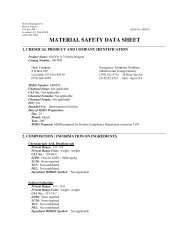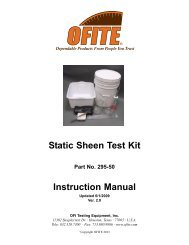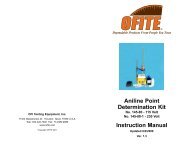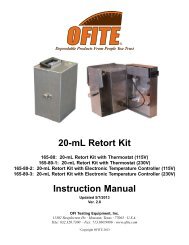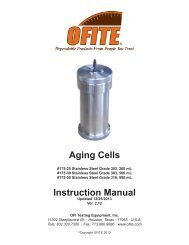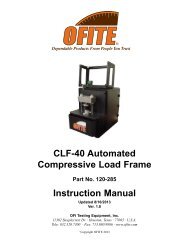Instructions - OFI Testing Equipment, Inc.
Instructions - OFI Testing Equipment, Inc.
Instructions - OFI Testing Equipment, Inc.
Create successful ePaper yourself
Turn your PDF publications into a flip-book with our unique Google optimized e-Paper software.
<strong>OFI</strong> <strong>Testing</strong> <strong>Equipment</strong> – 146-00 <strong>Instructions</strong> – Workover and Completion Fluids Test Kit Page 15 of 17<br />
Calculation:<br />
Mg ++ , mg/L =<br />
(mL EDTA, Total Hardness – mL EDTA, Ca++) x 243<br />
mL of Filtrate<br />
POTASSIUM & POTASSIUM CHLORIDE<br />
<strong>OFI</strong> Part No. 285-09<br />
Centrifuge Method: > 5000 Milligrams per Liter KCl (1% KCl)<br />
Potassium ion is used in drilling fluids to aid in the stabilization of shales and to control swelling clays. The accurate<br />
determination of the potassium ion content is necessary to control the properties of the drilling fluid. This procedure is<br />
used to measure the potassium ion content in mud filtrates at levels above 5000 milligrams per liter or 3.5 pounds per<br />
barrel KCl. The procedure is most accurate in the range between 10,000 mg/L (2%) and 40,000 mg/L (8%) KCl and is<br />
suspect below 10,000 mg/L (2%) KCl. Potassium is precipitated in a centrifuge tube as the perchlorate salt, and then the<br />
precipitate volume is measured. The potassium ion content is then read from a prepared standard curve.<br />
<strong>Equipment</strong>:<br />
#153-21 Centrifuge Tube, Kolmer, 10 ml (2 supplied)<br />
#153-25-2 *Centrifuge, Hand Crank, with dual head and shields<br />
#153-38 Pipette, 5 ml x 1/10 ml, glass<br />
Reagents:<br />
#206-02 Distilled Water, 16 oz<br />
#285-10 *Sodium Perchlorate sol'n, 16 oz (UN1502)<br />
#285-11 Potassium Chloride sol'n (standard), 4 oz<br />
Procedure - Generating a Standard Calibration Curve:<br />
1. A standard calibration curve is required for each type of centrifuge. A minimum of three points or test<br />
procedures (3.5, 10.5 & 17.5 pounds per barrel) is required to obtain an accurate graph.<br />
2. Samples can be prepared by using the standard potassium chloride solution where 0.5 ml of standard<br />
potassium chloride solution is equivalent to 3.5 pounds per barrel KCl.<br />
3.5 ppb KCl = 1 % KCL = 5000 mg/L ≅ 0.5 ml standard KCl solution.<br />
Therefore -<br />
A. To obtain 3.5 ppb equivalent KCl or 1% KCl use 0.5 ml of standard potassium chloride.<br />
B. To obtain 10.5 ppb equivalent KCl or 3% KCl use 1.5 ml of standard potassium chloride.<br />
C. To obtain 17.5 ppb equivalent KCl or 5% KCl use 2.5 ml of standard potassium chloride<br />
3. Dilute the samples in the centrifuge tube to the 7.0 ml mark with distilled water and agitate the mixture.<br />
4. Add 3 ml of standard sodium perchlorate solution to each centrifuge tube and do not agitate.<br />
5. Centrifuge at a constant speed of approximately 1800 revolutions per minute for one minute and read the<br />
precipitate volume immediately. It will be necessary to counterbalance the centrifuge tube with another tube<br />
and 10 ml of liquid of the same weight.<br />
A fairly constant 1800 revolutions per minute can be obtained by determining the number of revolutions of the rotor per<br />
each turn of the crank. Move the crank very slowly and count the number of revolutions of the rotor head during one turn<br />
of the crank. For example, 15 revolutions of the rotor per one turn of the crank. Calculate the number of crank turns<br />
required to obtain 1800 revolutions of the rotor head. In the example to obtain 1800 revolutions of the head would require<br />
120 turns of the crank (1800/15). Thus the crank must be turned 120 times in one minute to obtain the rate of 1800<br />
<strong>OFI</strong>TE • 11302 Steeplecrest Dr. • Houston, TX 77065 USA • Phone (832) 320-7300 • http://www.ofite.com<br />
Version 1.1<br />
Date 03-04-03



